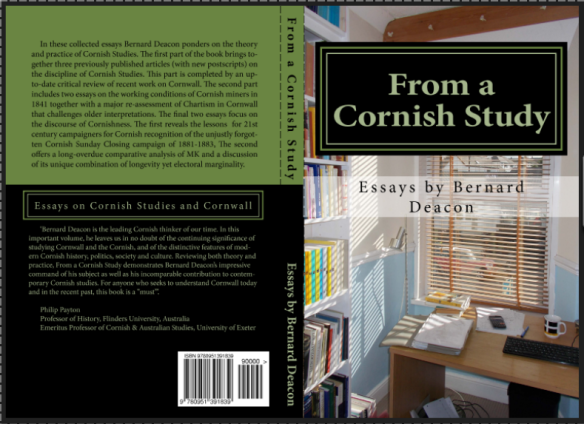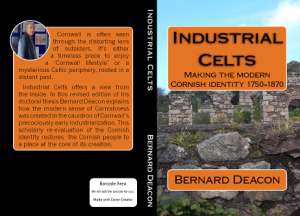My aim on this site is to provide a comprehensive first port of call for anyone seeking accurate and trustworthy information on Cornwall and its history. I’ll be adding more topics over time. Regular summaries and reviews of academic work on Cornwall can also be found here. Suggestions for further topics are welcome.
You’ll also find a full list of my own publications on the site, some of which have links to full text versions. (For those who don’t know me, I was Senior Lecturer in Cornish Studies at the Institute of Cornish Studies before retirement. Contrary to what you might read on Wikipedia I am Cornish, not English – born and brought up in Cornwall.) Meanwhile some details of my recent publications can be found below.
Extracts from readers’ reviews of The Real World of Poldark
from the UK: “Brilliant knowledgeable writer. Really enjoyed it. Very easy to read. Many things I didn’t know.”
from Australia: “This book is important because it gives a real insight into life in Cornwall during the years 1783 to 1820, when the Poldark books are set …This book is a must for lovers of Cornwall, readers of the Poldark novels, and anyone of Cornish descent as well as the general reader.”
from the USA: “The book is well researched, documented, and very readable including quotations from the newspapers of the period. Yes, reading about the real poverty, the callousness of the gentry toward the poor, the illness and death, squalid living conditions of many is tough but reality bites, doesn’t it.”
The Real World of Poldark: Cornwall, 1783-1820
You’ve watched the TV series. You’ve read the books. But what was the Cornwall of Poldark’s time really like? The gentry couldn’t have spent all their time galloping up and down the cliffs. So what did they do? Haymakers wouldn’t often have been scything with their shirts off. So what did they wear?
Moreover, were Cornish miners prone to riot? And why? What was the humble cottage like the one in which Demelza grew up actually like? Were prisons as bad as the one in which Jim Carter was kept?
What was Cornwall’s national sport? What happened during a religious revival? How rife was smuggling? Did wreckers loot ships? What did a bal maiden actually do? And who were the real models for the Warleggans?
In this book you’ll meet some of the characters that make up the background in the Poldark saga. People like the irascible and hyper-active Sir Francis Basset, John Opie the talented Cornish artist, and Richard Trevithick , the equally talented Cornish engineer. Moreover, you’ll be introduced to more humble folk, such as the woman who was convicted of poisoning her husband, the tramp who committed suicide in a lonely field and the clergyman who managed a parliamentary borough, not to mention the woman who conducted her own defence after she had accused him of corruption and was sued for libel.
The Real World of Poldark can be ordered from amazon at £9.99 for a paperback and £4.99 for ebook.
The chapters are …
- The Mine
- The Counthouse
- The Cottage
- The Road
- The Sea
- The Chapel
- The Plain an Gwarry
- The Crowd
- The Great House
- The Prison
- The Borough
My other most popular book has been The Surnames of Cornwall, a gazetteer of family names in Cornwall. This aimed to inject a bit more rigour into the study of surnames by looking at the historical evidence for their geographical distribution and at early spellings. This often enables us to pin down their origin and sometimes helps confirm suggested meanings. The Surnames of Cornwall
- gives the purported meanings for 760 of the surnames which were the most common or the most unique to Cornwall in past times.
- includes spelling variants of the names.
- describes the areas in which the names originated and where they were found in the 1800s.
- notes some well-known bearers of some of the names.
- includes an introduction setting out the context for the study of surnames.
The book is supported by maps (see example below), which are online at this site. These provide snapshots of the distribution of names in the 1861 Census. This book is now available from Amazon for £9.99 (+ postage). Copies can be purchased direct from me. It is also available from The Edge of the World Bookshop, Penzance. There is also an ebook version available from Amazon for £4.99.

Also available from Amazon for £9.99 + postage
Industrial Celts explains how Cornwall’s early industrialisation produced a unique society and a distinct regional culture. Socially, Cornwall became home to a dispersed paternalist society. In economic terms, it was based on mining and merchant capitalism. Culturally, it was dominated by Methodism. The twin symbols of mining and Methodism became central to a sense of Cornishness, encapsulated in the popular dialect literature that flourished in the mid-1800s. At the same time, identification of the Cornish as Celts became more widespread. That self-description had been recognised by Cornish historians as early as the 1700s and did not have to await either the later ‘Cornish Revival’ or romantic, metropolitan dreamers. Moreover, early de-industrialisation and mass emigration meant that Cornwall’s rural industrial economy and society retained material differences well into the twentieth century. However, the sense of identity produced by its industrialisation had its limits and proved incapable of competing with more powerful territorial discourses. Industrial Celts, a revised and more accessible version of my doctoral thesis, restores the importance of Cornwall’s industrial period to the modern sense of Cornishness and is an essential addition to the corpus of scholarly work on Cornwall’s past.
For a chapter by chapter synopsis see here.
If you’re interested in this can you afford to miss From a Cornish Study: essays on Cornish Studies and Cornwall?
This 226 page book, published in 2017, is available from Amazon at £9.99 plus postage or the Federation of Old Cornwall Societies bookshop or the Royal Cornwall Museum shop, Truro or direct from me.



Hi there.. I am have just started doing my family tree for PETHERICK. I live in New Zealand so therefore our name is quite uncommon here. I have so far gone back approximately 500years and have traced my 10th Great Grandfather which is so exciting and it seems most of us have derived from Cornwall.I have lived in NZ all my life of 55 years. I am interested in what you may know about the name PETHERICK.
Kindest regards
Denise Clevis nee Petherick
LikeLike
Your Blog looks like it is loaded with Cornish Information. Great Work.
LikeLike
Interested to read your blog on Cornish names before the Conquest. My mother’s maiden name was Lewarne and I noticed the close alignment to Iarnwallon as mentioned in your blog. We have always believed that the name came from the Brittany region but maybe it is a corruption of the earlier Cornish? I know that there are a few place names called Lewarne.
Richard Curnow
LikeLike
Very many place names in Brittany are used as surnames in Cornwall, with almost the same spelling.
LikeLike
Re: Anglo Cornish dialect – I think it is a conscious attempt by many of us who grew up at a time when distinct dialect words and phrases were in constant everyday use, to maintain the distinctiveness of locality and resist the flattening of Cornish identity under the influx of standard media English and also continuing settlement by those from other parts of the UK. Dialect – especially very local – has a powerful emotional hold on us from early childhood.
LikeLike